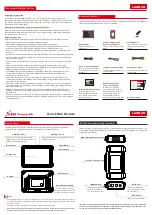
– 3 –
ORO-PULSE OXIMETER USER’S MANUAL
SECTION 1: SAFETY
1.1 Instructions for the Safe Operation and Use of the Pulse Oximeter
• Do not attempt to service the pulse oximeter. Only qualified
service personnel should attempt any needed internal servicing.
• Do not use the oximeter in situations where alarms are required.
• Prolonged use or the patient’s condition may require changing the
sensor site periodically. Change sensor site and check skin integri
-
ty, circulatory status and correct alignment at least every 2 hours.
• SpO
2
measurements may be adversely affected in the presence of
high ambient light. Shield the sensor area (with a surgical towel, or
direct sunlight, for example) if necessary.
• The following reasons will cause interference.
• High-frequency electrosurgical.
• Placement of a sensor on an extremity with a blood pressure cuff
arterial catheter, or intravascular line.
• The patient has hypotension severe vasoconstriction severe ane
-
mia or hypothermia.
• The patient is in cardiac arrest or is in shock.
• Fingernail polish or false fingernails may cause inaccurate SpO
2
readings.
1.2 Warnings
WARNING:
EXPLOSION HAZARD — Do not use the oximeter
in a flammable atmosphere where concentrations of flammable
anesthetics or other materials may occur.
WARNING:
Do not throw batteries in fire as this may causes them to
explode.
WARNING:
Do not use the pulse oximeter in an MRI or CT environ
-
ment.
CAUTION:
Keep the operating environment free of dust, vibrations, cor
-
rosive, or flammable materials, and extremes of temperature and humidity.
CAUTION:
Do not operate the unit if it is damp or wet because of
condensation or spills. Avoid using the equipment immediately after
moving it from a cold environment to a warm, humid location.
WARNING:
Do not attempt to recharge normal dry-cell batteries, they
may leak. And may cause a fire or even explode.
CAUTION:
Never use sharp or pointed objects to operate the front
-
-panel switches.
CAUTION:
The battery must be taken out from the battery compart
-
ment if the device will not be used for a long time.
CAUTION:
The device shall only be used if the battery cover is closed.
CAUTION:
The battery must be proper disposed according to local
regulation after their use.
1.3 Definitions and Symbols
Symbol
Description
Symbol
Description
Type BF Equipment
Information of manufacture,
including name and address
Refer to the instruction
manual /booklet
When the end-user wishes
to discard this product, it
must be sent to separate
collection facilities for
recovery and recycling
Serial NO*
Note
The important information
you should know
Caution
The information you should
know to protect the equip
-
ment from possible damage
Warning
The information you should
know to protect patients
and medical staff from
possible injury
SECTION 2: INTRODUCTION
2.1 Brief Device Description
The Pulse Oximeter, based on all digital technology, is intended for noni
-
nvasive spot-check measurement of functional oxygen saturation of arte
-
rial hemoglobin (SpO
2
). Advanced DSP algorithm can minish the influence
of motion artifact and improve measurement accuracy of low perfusion.
The Oximeter can be used to measure human Hemoglobin Saturation
and heart rate through finger.
The product is suitable for family, Oxygen Bar, social medical organi
-
zations, physical care in sports and etc. in the case of saturation below
80%, contact your doctor.
2.2 Intended Use
The product is dedicated for unprofessional user and can be used in
house conditions.
2.3 Product Features
• Lightweight for carrying and Easy-To-Use.
• Manually adjust the direction of interface .
• OLED display, simultaneous display for testing value and plethy
-
smogram.
• Visual alarm function. Real-time spot-checks.
• Low Battery voltage indicator.
• Automatically standby or sleep.
SECTION 3: INSTALLATION, SETUP, AND OPERATION
3.1 Description of the Front Panel
Item
Name
Description
1
OLED Panel
Display the SpO
2
/PR data & Bargraph, Plethysmogram,PI
2
Key
Start the working state
3
Battery
Compartment
2*AAA 1.5V Alkaline battery
3.2 Display
After switch on, the OLED display is as follows:
3.3 Parameter setting
Press the direction button (>0.5s), the oximeter will enter into parame
-
ter seting. There are two submenu for choice:
• When the „*” signal is show on the „Sounds setup”, press the but
-
ton (>0.5s), and enter into the sounds setting menu(Figure a), you
can press the button in turn to select the item, and press the
button to change the data you need. Select „+” or „-” to increase
or decrease the number of settings.
• When the „*” signal is show on the „Alm setup”, press the button
(>0.5s), and enter into the alarm setting menu(Figure b). Press the
button to set on/off the alarm and beep.
When the „* ” signal is show on the „Restore”, press the button (>0.5s)
and or the settings are back to the factory settings.
Settings
Alm Setup *
Alm
off
Beep
off
Demo
off
Restore
OK
Brightness 4
Exit
Settings
Sounds Setup *
SpO
2
Alm Hi 100
SpO2 Alm Lo 94
PR Alm Hi
130
PR Alm Lo
50
+/-
+
Exit
Figure A
Figure B
3.4 Operation
Install battery
Installing two AAA batteries into battery cassette in correct polarities
and cover it (as Figure)
Battery indicator
SpO
2
PR
Key
Direction
Indeks perfuzji
Pletyzmogram
Wykres słupkowy






















